Natural-born tool makers
How does a juvenile New Caledonian crow begin to make and use tools? Does it need teaching? Will it figure it out by itself? Does it just follow instructions written in its genes?
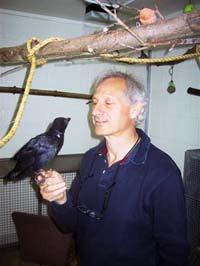 We can now answer some of these questions, after observing the development of
four juvenile crows hatched in our captive colony in Oxford (see
Breeding). All
four birds were hand-raised by human foster parents. Two of the juveniles (“Uék”
and “Nalik”) had daily lessons in tool use: a human demonstrator would use
sticks to extract food from artificial holes in their aviary. The other two
juveniles (“Oiseau” and “Corbeau”) never saw any tool-like object being handled,
but otherwise received the same degree of attention from their human caretakers.
(Incidentally, the crows’ names mean ‘bird’ and ‘crow’ in local languages of New
Caledonia.)
We can now answer some of these questions, after observing the development of
four juvenile crows hatched in our captive colony in Oxford (see
Breeding). All
four birds were hand-raised by human foster parents. Two of the juveniles (“Uék”
and “Nalik”) had daily lessons in tool use: a human demonstrator would use
sticks to extract food from artificial holes in their aviary. The other two
juveniles (“Oiseau” and “Corbeau”) never saw any tool-like object being handled,
but otherwise received the same degree of attention from their human caretakers.
(Incidentally, the crows’ names mean ‘bird’ and ‘crow’ in local languages of New
Caledonia.)
By the age of 79 days, all four juveniles could retrieve food from crevices using stick tools (Kenward et al. 2005). This proves that teaching is not necessary for the development of tool use, although the young crows did ‘practise’ individually before becoming proficient.
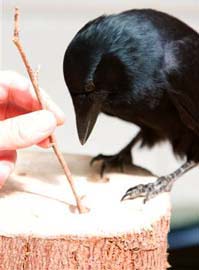
© Simon Walker
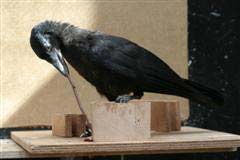
© Ron Toft
We also exposed the juveniles to Pandanus leaves, similar to those used by crows in the wild to make some of their most sophisticated tools (see Crow natural history). All four juveniles tore shreds off the leaves, and Corbeau—one of the naïve birds—successfully made and used his first pandanus tool less than 3 hours after seeing the plant for the first time ( Kenward et al. 2005).
Interestingly, the shreds and tools made by our captive juveniles were crude and lacked the step-cuts characteristic of the tools made by wild adult crows. It is therefore possible that social learning plays a role in the acquisition of more sophisticated manufacturing techniques and tool designs. This idea is supported by the close attention our juveniles paid to demonstrations of tool use by their human foster parents.
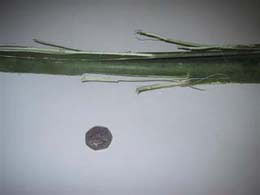
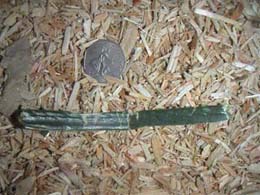
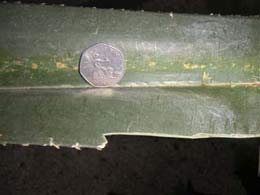
Movies
These Windows Media Player (.wmv) movies are better quality versions of those appearing in the supplementary material for the paper.
Tool use demonstration
Movie 1 This illustrates the human foster parent (BK) demonstrating food-retrieval with a twig tool to an immature female hand-raised New Caledonian crow ("Uék", then aged 98 days). Note that Uék holds on to the end of the stick that the demonstrator is using, and that after eating the food she picks up and manipulates the twig (which is still inserted in the hole).
Naïve crow’s (Oiseau) second tool use
Movie 2 This shows the second occasion "Oiseau" (one of the untutored juveniles, then aged 65 days) was observed to retrieve food from a crevice with a tool. Although twigs were provided next to the crevices, he carried a stick there from the ground. Note that the tail and the plumage around the eyes are not fully grown, and that he rather clumsily falls off the platform after retrieving the food, indicating he was still morphologically and behaviourally immature.
Naïve crow (Corbeau) cutting out pandanus tool
Movie 3 This footage shows Corbeau (then aged 99 days) cutting out a pandanus tool with a "cut-tear-cut" action, and then transporting it to a platform containing several crevices, where food is normally provided. He probes a crevice, although on this occasion there was no food present. Beforehand, he probes some of the cracks between the pandanus support frame and the perches.
Corbeau probing with pandanus tool
Movie 4 This shows Corbeau (then aged 101 days) bringing a pandanus tool to the crevice platform, probing first one, which is empty, and then a second, from which he obtains food. Note that this tool is roughly shaped compared to those made by adult wild crows.
Corbeau tearing off a strip of pandanus.
Movie 5 This shows a close up of Corbeau (then aged 126 days) cutting into the edge of a pandanus leaf and tearing a piece off. On this occasion, the piece breaks off at the far end due to previous damage to the leaf, and there is no need for Corbeau to make a second cut himself. He then carries the piece to the crevices, but does not probe. Before he makes this piece, he breaks off a much smaller piece which he immediately drops. Note that he is semi-bald because of natural head moult.
References
Kenward, B. et al. (2005). Tool manufacture by naive juvenile crows. Nature, 433: 121. DOI 10.1038/433121a
